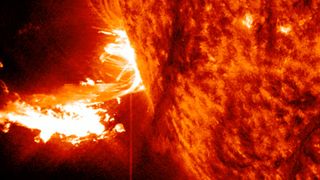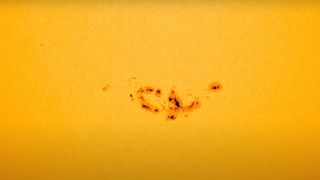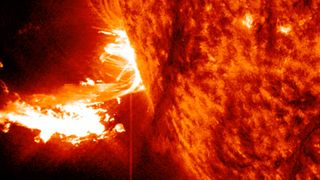The colossal sunspot group AR3664 responsible for the epic May 2024 solar storms and widespread auroras is back — well, almost.
Yesterday (May 27), a powerful X-class solar flare erupted from the sun‘s southeastern limb, peaking around 3:08 a.m. EDT (0708 GMT).
Solar flares are energetic eruptions of electromagnetic radiation from the sun’s surface that occur when magnetic energy accumulating in the solar atmosphere is released. They are categorized by size into lettered groups, with X-class being the most powerful. Within each class, numbers from 1-10 (and beyond for X-class flares) describe a flare’s relative strength. The recent X-flare clocked in at an X-2.9 according to Spaceweatherlive.com
Related: We may have just witnessed some of the strongest auroras in 500 years
But how do we know that the solar flare came from AR3664 if we can’t yet ‘see’ the sunspot group?
Though sunspot group 3664 remains hidden from NASA’s Solar Dynamics Observatory‘s view — scientists can track the sunspot’s progress across the sun’s far side by observing how it affects the sun’s vibrations or seismic echoes, using helioseismology data. One full rotation of the sun takes 27 days.
A map from spaceweather.com tracking the current location of AR3664 places it just beyond the sun’s southeastern limb, where the X-flare originated.
Considering AR3664’s penchant for X-flares and that it had been observed in the vicinity of yesterday’s explosive solar flare eruption, it seems a reasonable deduction that AR3664 is the culprit.

This is exciting news for space weather enthusiasts and aurora chasers as AR3664 will turn to face Earth later in the week. The hyperactive sunspot group is the most active of the sun’s current solar cycle and the recent X-flare could prove it’s still up to its old tricks.
However, when AR3664 rotates back into view it will take on a new identity and no longer be known as AR3664. This is because although it’s likely the returning region is AR3664, due to limited sunspot observations to track sunspots on the sun’s far side, scientists cannot be certain this is the case. All sunspots rotating into view are therefore renamed.

The recent X-flare on May 27 was also accompanied by a coronal mass ejection (CME) whereby plasma and magnetic field are expelled from the surface of the sun in explosive fashion. However, a NASA model shows the CME will not strike Earth.
Related stories:
The solar flare eruption also triggered shortwave radio blackouts across East Asia. Shortwave radio blackouts are common shortly after powerful solar flare eruptions due to the strong pulse of X-rays and extreme ultraviolet radiation emitted during these events. The radiation travels toward Earth at the speed of light and ionizes (gives an electrical charge to) the top of Earth’s atmosphere when it reaches us. This ionization causes a higher-density environment for the high-frequency shortwave radio signals to navigate through to support communication over long distances.
The radio waves that interact with electrons in the ionized layers lose energy due to colliding more frequently, and this can lead to radio signals becoming degraded or completely absorbed according to NOAA’s Space Weather Prediction Center.



